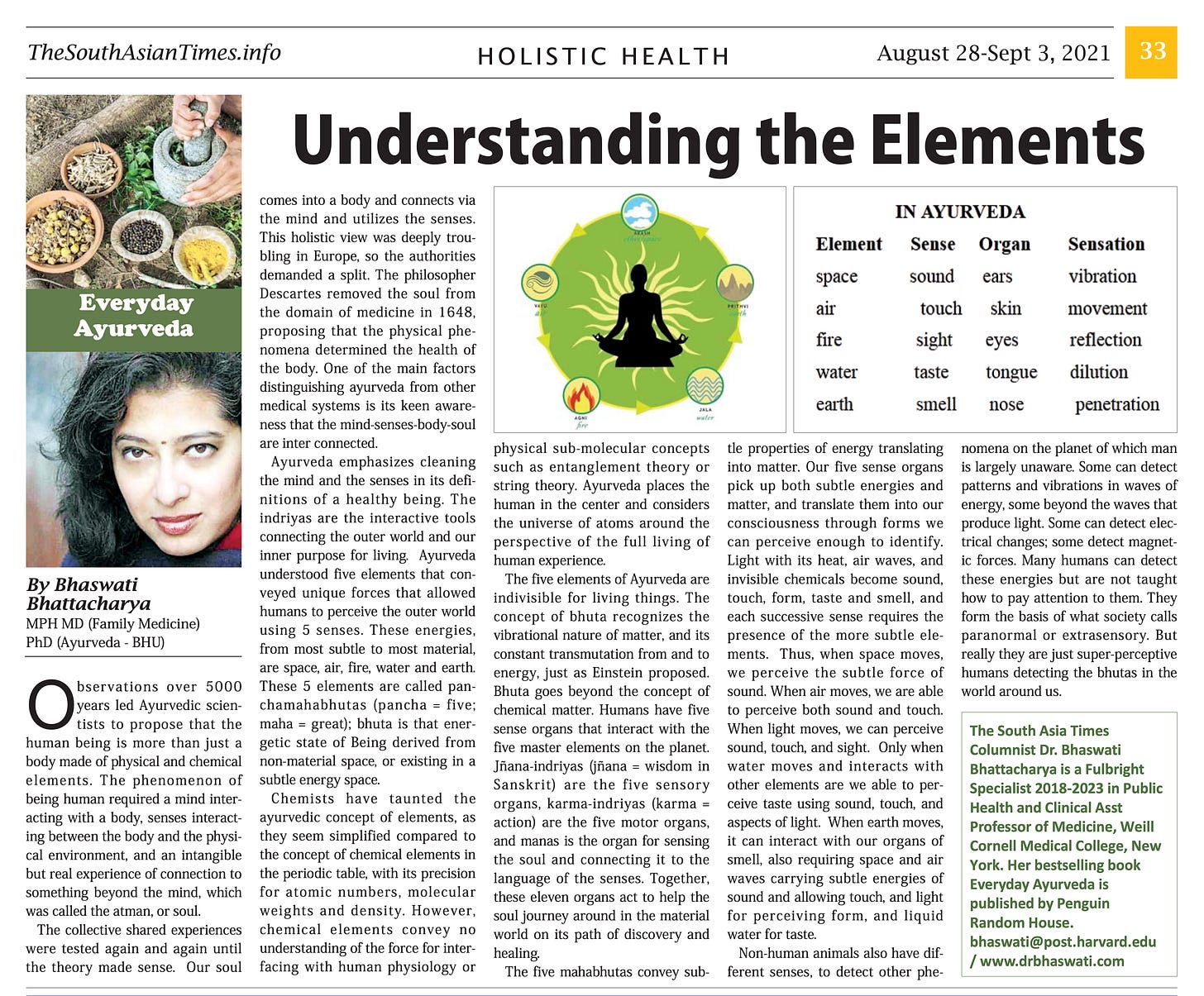Understanding the Elements
Our five sense organs pick up both subtle energies and matter, and translate them into our consciousness through forms we can perceive enough to identify. Light with its heat, air waves, and invisible chemicals become sound, touch, form, taste and smell, and each successive sense requires the presence of the more subtle elements.
Observation-based Evidence
Observations over 5000 years led Ayurvedic scientists to propose that the human being is more than just a body made of physical and chemical elements. The phenomenon of being human required a mind interacting with a body, senses interacting between the body and the physical environment, and an intangible but real experience of connection to something beyond the mind, which was called the atman, or soul.
The collective shared experiences were tested again and again until the theory made sense. Our soul comes into a body and connects via the mind and utilizes the senses. This holistic view was deeply troubling in Europe, so the authorities demanded a split. The philosopher Descartes removed the soul from the domain of medicine in 1648, proposing that the physical phenomena determined the health of the body. One of the main factors distinguishing ayurveda from other medical systems is its keen awareness that the mind-senses-body-soul are interconnected.
Ayurveda emphasizes cleaning the mind and the senses in its definitions of a healthy being. The indriyas are the interactive tools connecting the outer world and our inner purpose for living. Ayurveda understood five elements that conveyed unique forces that allowed humans to perceive the outer world using 5 senses. These energies, from most subtle to most material, are space, air, fire, water and earth. These 5 elements are called panchamahabhutas (pancha = five; maha = great); bhuta is that energetic state of Being derived from non-material space, or existing in a subtle energy space.
Chemists have taunted the ayurvedic concept of elements, as they seem simplified compared to the concept of chemical elements in the periodic table, with its precision for atomic numbers, molecular weights and density. However, chemical elements convey no understanding of the force for interfacing with human physiology or physical sub-molecular concepts such as entanglement theory or string theory. Ayurveda places the human in the center and considers the universe of atoms around the perspective of the full living of human experience.
The five elements of Ayurveda are indivisible for living things. The concept of bhuta recognizes the vibrational nature of matter, and its constant transmutation from and to energy, just as Einstein proposed. Bhuta goes beyond the concept of chemical matter. Humans have five sense organs that interact with the five master elements on the planet. Jñana-indriyas (jñana = wisdom in Sanskrit) are the five sensory organs, karma-indriyas (karma = action) are the five motor organs, and manas is the organ for sensing the soul and connecting it to the language of the senses. Together, these eleven organs act to help the soul journey around in the material world on its path of discovery and healing.
The five mahabhutas convey subtle properties of energy translating into matter. Our five sense organs pick up both subtle energies and matter, and translate them into our consciousness through forms we can perceive enough to identify. Light with its heat, air waves, and invisible chemicals become sound, touch, form, taste and smell, and each successive sense requires the presence of the more subtle elements. Thus, when space moves, we perceive the subtle force of sound. When air moves, we are able to perceive both sound and touch. When light moves, we can perceive sound, touch, and sight. Only when water moves and interacts with other elements are we able to perceive taste using sound, touch, and aspects of light. When earth moves, it can interact with our organs of smell, also requiring space and air waves carrying subtle energies of sound and allowing touch, and light for perceiving form, and liquid water for taste.
Non-human animals also have different senses, to detect other phenomena on the planet of which man is largely unaware. Some can detect patterns and vibrations in waves of energy, some beyond the waves that produce light. Some can detect electrical changes; some detect magnetic forces.
Many humans can detect these energies but are not taught how to pay attention to them. They form the basis of what society calls paranormal or extrasensory. But really they are just super-perceptive humans detecting the bhutas in the world around us.
week 74. TheSouthAsianTimes.
Download the .pdf version of this column by clicking on the image.
Dr. Bhaswati Bhattacharya is a Fulbright Specialist 2018‐2023 in Public Health. She serves as Clinical Asst Professor of Family Medicine in the Department of Medicine at Weill Cornell Medical College in New York, NY.
Her bestselling book Everyday Ayurveda is published by Penguin Random House. To order an autographed copy, write to bhaswati@post.harvard.edu.




